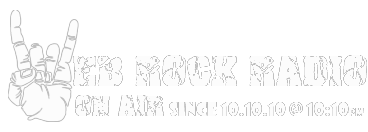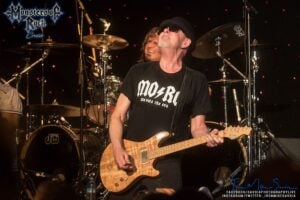
Photo by Iron Mike Savoia
In an era where outrageous shred antics, big hair, and pointy guitars reigned supreme, Mark Kendall injected blues in the Eighties hair metal scene via Les Pauls, ES-335s, and custom-made curios.
With Great White, Kendall reminded the world that the blues had a place alongside the slick metal licks perpetrated on Headbangers Ball, which stemmed from a love for the timeless vintage gear he watched his heroes play in the Sixties and Seventies. “I was a teenager using Fender Bassmans,” Kendall tells ClassicRockHistory.com. “Even then, I wanted natural distortion created by pushing tubes hard.”
He continues, “I learned that by turning the volume down, the amp I had would saturate the tubes, and I could get distortion that way. Looking back, what I’ve chased all these years is trying to make the notes as loud as I can but not lose my sound in the process.”
Timeless albums like Once Bitten (1987), …Twice Shy (1989), and Hooked (1991) are proof that Kendall, despite his humble nature, accomplished his goal. “You keep troubleshooting,” he says. “And you try to keep getting better. But I will never forget when we met Alan Niven; I was noodling around, trying to play like Alvin Lee, and he said, ‘You should be doing more of that.”
He explains, “That wasn’t so common back then, but it made me feel free to do whatever. It’s like, ‘Yeah, just play from the heart, man.’ You know what I mean? That’s when we started coming up with stuff like ‘Rock Me’ and the songs we became known for in the mid to late-Eighties.”
Though Great White did rise to fame in the Eighties, aka the hair metal era, leading to the band being perpetually lumped in with the genre, Kendall never felt remotely close to it. “My hair has never written a song,” he laughs. “I play the way I do from listening to Carlos Santana and Johnny Winter.”
“As far as being lumped in with the hair metal thing,” he adds. “I always related that to fashion. If we’re talking about fashion, yeah, I get it. The same guy making Mötley Crüe and Ratt’s stuff made ours. But if we’re talking about music, if you listen, our band, we had blues overtones—especially from my end.”
As for how Kendall views Great White’s place in it all, he admits, “I guess it’s easy for a journalist to call use’ hair metal,’ or whatever. But if they were to research the music and listen to the deep cuts, they’d hear the blues influences and that we were more musical. Just look at a lot of the music—it doesn’t sound like ‘hair metal.’
“So, I don’t know,” he says. “I think a lot of it comes down to taking the workload off a lot of journalists, where they can just lump us—and a whole decade—in with hair metal and call it that, rather than listening to it for what it really is and looking at what really set us apart.”
“Stick It”
Great White – Great White (1984)
With “Stick It,” we used to do demos back when we were called Dante Fox, which was the name of our band. And believe me… trying to think of a name, well, anybody who has been through naming your band, you know it’s absolute torture. Anyway, “Stick It” was one of our early songs, and when we were approached by [manager] Alan Niven, he pushed us to get the strength out of the band and its songs.
At that point, Alan thought we were a little weak lyrically, but the music didn’t really change from the original demo. But the lyrical content of “Stick It” changed a bit… some of the lyrics were kept, but there was a different chorus; things got tweaked. But all bands go through that, you know? If you’ve heard some of Van Halen’s early demos, there are parts that are taken from one song and put into another; that’s just a natural thing that happens as you try to improve.
But the music didn’t really change; I was playing through an old Marshall I had through a cabinet. And the thing about recording through four twelves is you need a lot of microphones because there’s so much EQ floating around. I’ve learned over the years that playing through combo amps is a lot better because they go on tape exactly as you hear them, but when you’re standing next to a cabinet, it’s different. But between the Marshall and my BC Rich guitars—who I had an endorsement with, that pretty much made up all of “Stick It” and the whole first album.
“Rock Me”
Great White – Once Bitten (1987)
“Rock Me” came on our third album. After the second album [Shot in the Dark], we were just really trying to find the sound, and after Alan Niven really opened me up and said, “Just be free. Play from the heart,” that’s when a lot of blues influences came out. When I was coming up with “Rock Me,” I was kind of just hammering on one note and then playing with my thumb and playing the intro part.
And then, Michael Lardie, who was our rhythm guitar player, he came up with one section, and I wrote the chorus. That song was the first time I felt like our true influences came out and that we were honest with ourselves. Instead of trying to be something else, we were really honest about who we were.
And I remember that Alan Niven threw me in a garage and was like, “Go write an album,” which was just crazy. I was basically living on the beach, you know, in Redondo Beach. I was right there on the beach in this small condo, and I’d hang out in the garage all day writing stuff. After things were fleshed out, the band would collaborate, jam, and get into the rehearsal space, which is where I’d come up with guitar parts and arrangements.
“Once Bitten, Twice Shy”
Great White – …Twice Shy (1989)
The funny thing about “Once Bitten, Twice Shy” is that it happened just by coincidence when we were touring with Judas Priest. What happened was we had all the material for the …Twice Shy album most recorded, and Alan Niven came to us with that song and said, “I’d like you to do this.” And, you know, we thought it was an okay song to throw on the record, but he really liked the lyrics.
We ended up putting our own spin on it because it wasn’t done out of desperation, like, “Oh, we need to do a cover song because we’re a little short on material.” It wasn’t like that. Because if that was the case, we would have looked for an old hit, you know? That’s usually the trick; you find the hit, and do it again by taking that hit, and putting a spin on it.
But “Once Bitten, Twice Shy” wasn’t even really known in America. It was never a big hit, and we were just doing it because Alan Niven liked it. We liked it, too, but we had no idea it was going to be a single. So, how I remember “Once Bitten, Twice Shy” was that it was kind of brought in at the last minute, and we learned the song and tweaked the lyrics a bit.
But our version sounded kind of badass and rawer, so the record company flipped out, made it a single, and were basically jumping around the room. [laughs] Maybe it was rawer because I went with a more traditional sound that wasn’t overly distorted. I used my Gibson ES-335; it just seemed to fit. The tone wasn’t too fat, very pure, and kind of standard, not like typical heavy metal. And for the solo, I didn’t want to use a Strat or something thin, and I wasn’t into the Les Paul for that, so the 335 worked perfectly there, too.
“The Angel Song”
Great White – …Twice Shy (1989)
I actually wrote all the music for “The Angel Song” on guitar and came in to kick it around with the band after the fact. Alan Niven really liked it, but he felt it would be better if it was transposed onto a piano and made it more of a piano-driven song. So, Michael Lardie, who also played keyboards, took the music I did on guitar, made it a piano song, and then, I played around with that and did a melodic solo over it.
A lot of songs happened like that where they were written on guitar and then changed around and delivered differently later. But what was also cool is that on “The Angel Song,” I used a guitar made by a guy named Jim Foote, who had a music store called Music Works in Redondo Beach. He made a few guitars for Jake E. Lee, and they were just really good guitars, man.
We used to rehearse at Music Works, so we were close to Jim, and he made me this awesome guitar with EMG pickups, which was perfect for that song. I wanted the verses to be kind of clean, and I basically used the guitar Jim made me and went with a very clean tone over the piano stuff Michael did. I remember everyone thinking it was a really nice solo, and I was very happy with the clean tone over the verses, too.
“Desert Moon”
Great White – Hooked (1991)
Michael Lardie actually came up with the changes on “Desert Moon.” The chorus had this repeating part over the changes, doing the same thing over and over, while the chords had those movements. I have memories of working out all the changes with Michael in rehearsals, which was awesome because, lyrically, I knew the song was pretty good.
But we had a break during the tour we did with Tesla, and we went to the Bahama for five days. We came back, and we had “Desert Moon” done, and we played that song live at Electric Lady Studios, and we had radio stations from all over the country come to New York to watch us play it. So, we knew it was a good song, but it all stemmed from Michael Lardie and jamming—which is how a lot of our stuff came together, just in a rehearsal room.
And on that song I used a dimmed Marshall. I used to change guitars to fit any given song a lot, but back then, I used Marshalls most of the time. I think I used one of the guitars Jim Foote made me on that track, too. I had a record one with EMG single-coil pickups, which I’d use for real clean sounds; I think I used that one. And of note, I’d changed to La Bella strings, which were not known years ago for their electric guitar strings, but Vivan Campbel turned me onto them, and they were just so live-sounding and didn’t tear my hands up.
Read More: Artists’ Interviews Directory At ClassicRockHistory.com
Read More: Classic Rock Bands List And Directory






